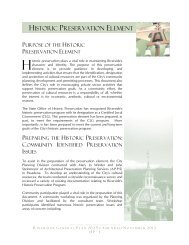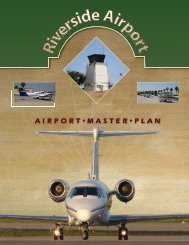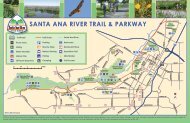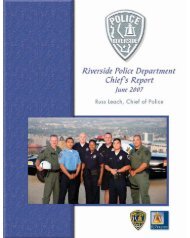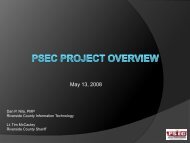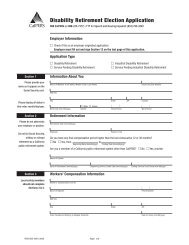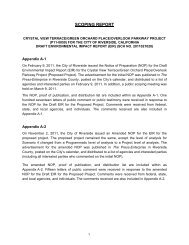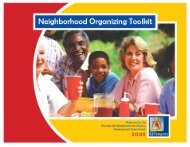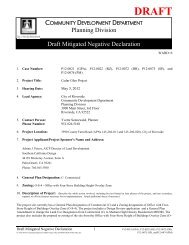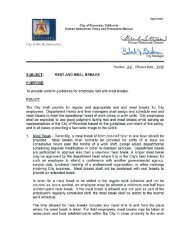Northside - City of Riverside
Northside - City of Riverside
Northside - City of Riverside
Create successful ePaper yourself
Turn your PDF publications into a flip-book with our unique Google optimized e-Paper software.
One potential historic district, the North Hill Historic District, was identified during<br />
the survey process and represents the cohesive development <strong>of</strong> a small, exclusive<br />
area overlooking Fairmount Park with a concentration <strong>of</strong> large-scale, high style<br />
single-family residences in a mix <strong>of</strong> period revival style architecture <strong>of</strong> the eclectic<br />
1920s and 1930s: Tudor Revival, Spanish Colonial Revival, Monterey Revival, French<br />
Eclectic, Pueblo Revival, and Minimal Traditional styles. Most residences are<br />
architect-designed, and unique, contributing light standards extant on Randall<br />
Street, the west end <strong>of</strong> Houghton Avenue, and Pine Street, were likely specifically<br />
selected for this development as they appear no where else in the survey area or in<br />
the <strong>City</strong>. As mostly small-scaled, turn-<strong>of</strong> and early-century residences boast style<br />
popular before period revival styles took over the face <strong>of</strong> 1920s and 1930s<br />
subdivisions in <strong>Riverside</strong>, the presence <strong>of</strong> large, high-style examples is made more<br />
striking (see Survey Findings).<br />
Residents who settled on the <strong>Northside</strong> during this time may have been new arrivals<br />
or may have sought relief from population pressures in the Mile Square. Although<br />
the <strong>City</strong>’s population roughly doubled, construction within the survey area during<br />
this time more than tripled with over 330 new homes constructed (County <strong>of</strong><br />
<strong>Riverside</strong> 2003), indicating that many chose to settle on the <strong>Northside</strong> According to<br />
city directories, <strong>Northside</strong> residents in the 1920s and 1930s were a mix <strong>of</strong> blue- and<br />
white-collar workers, including laborers, painters, teachers, clerks, carpenters,<br />
engineers, electricians, contractors, farmers, mechanics, and janitors.<br />
As elsewhere, residential development stalled during the depressed early 1930s,<br />
and, though building picked up in the survey area in 1936, a paralyzing freeze in<br />
1937, which decreased citrus production 37% (Patterson 1996:379-80), kept<br />
construction in a general slump. Though three tracts are divided in the 1930s (see<br />
table below), <strong>of</strong> the 21 years within this period <strong>of</strong> development, about 75% <strong>of</strong><br />
construction was completed by 1930. With the onset <strong>of</strong> another world war, strong<br />
residential development would take years to rebound.<br />
COMMERCIAL/INDUSTRIAL DEVELOPMENT<br />
During this period, decreased dependence on agriculture and citrus both<br />
contributed to and was influenced by the diversification <strong>of</strong> commercial/industrial<br />
interests. Population increases, particularly in the 1920s, necessitated diversification<br />
as much as the depression and devastating nighttime freeze that followed did in the<br />
1930s. While economic interests became broader, geographically, commercial and<br />
industrial enterprise seemed to consolidate as some areas became increasingly<br />
associated with these uses. Neighborhood stores and shops like Dodge’s Grocery<br />
(1923 to ca. mid-1960s), a <strong>City</strong> Structure <strong>of</strong> Merit (#541) and contributor to the<br />
Heritage Square Historic District at 3339 First Street and another at 4041 First Street<br />
106



